What is Edge Computing?
You may wonder where we are headed in teh It is a distributed computing framework that brings enterprises closer to data sources. A local edge server brings the workload close to the edge. The growth in data processing capabilities ensures that data processing is mostly at the user site. Only complicated processes are at a remote server. While we no longer have to worry about data space, there is a need to optimize the use of what is available.

History
Computing has come a long way from the time it was expensive to store and process data. Earlier, we had the existence of client-server models. In this model client (front end) did all the data entry, while the server did all the processing. Technological advancement has rapidly ensued with very affordable storage space. Computers have moved now to our homes, phones, offices, cars. There are requirements for real-time data processing and the emergence of artificial intelligence (AI). There is also a wide range of Internet of Things (IoT) applications. Edge computing is an area with rapid growth for different applications. It is an area of research. If you are a company interested in Edge computing here is an edge computing review.
Applications
Supports the processing of data for the real-time application so that the data does not have to be moved long distances and delay action. Generally, all operations that require data storage and computation closer to the location would benefit from this distributed system paradigm. Data is processing is at a logical edge of the network as opposed to centralized nodes. The technology can be in a company, factory, vehicles, planes, trains. It involved the deployment of several applications at different sites.
Benefits of edge computing?
- High bandwidth,
- Low latency
- Data security, reliable configuration and storage

Other Technologies
5G Technology
The expectations are that 5G technology and Edge computing will complement each other resulting in superior internet capabilities globally. Consumers and business will benefit from the integration of these technologies. The communication service providers (CSP) will have an opportunity to improve value to their customers.
Internet of Things
Bringing processing capabilities closer will ensure efficiency and quick processing hence quick decisions. A good example is when you use in service automation will lead to low turnaround time and low costs. It will also simplify operations.
Edge computing Vs Fog computing
Sometimes both terms are used interchangeably. In edge computing processing happens at the edge is very close to the gadget. Fog nodules carry out data analysis before it is sent to the cloud hence making it more efficient. The estimates of fog market will be worth $6.4 billion by 2022. Both try to solve the problem of inefficiency.
Cloud computing
Edge computing and cloud computing are complementary technologies. The difference is in where the processing of data takes place. The former involves data processing at the equipment site hence distribution. Cloud computing involves the centralized processing of data at the cloud.
Edge computing examples
Applications vary. The technology is already in use on the internet of Things (IoT). We expect to see more of the application in smart cities, healthcare, manufacturing. Anywhere you will need to have data processing at the site and, fewer data moved around and operation efficiency. Other applications include AI virtual assistant, autonomous cars, home automation systems.
Our take
There are a variety of opportunities that present themselves through the introduction of edge computing. Businesses should be on the lookout to be the first in their field to incorporate the technology to reap maximum benefits.












Leave a Reply